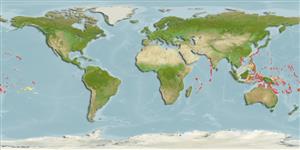>
Kurtiformes (Nurseryfishes, cardinalfishes.) >
Apogonidae (Cardinalfishes) > Apogoninae
Etymology: Apogon: Greek, a = without + Greek pogon = chin, beard (Ref. 45335); caudicinctus: From the Latin word 'cauda' for tail and 'cinctum' for girdle or belt, in reference to the broad blackish bar across the posterior caudal peduncle and base of caudal fin..
More on authors: Randall & Smith.
Environment: milieu / climate zone / depth range / distribution range
Ecologia
marinhas associadas(os) a recifes; intervalo de profundidade 0 - 40 m (Ref. 126002). Tropical; 30°N - 22°S, 54°E - 130°W
Indo-Pacific: Réunion Island, and Mauritius (Ref. 33390) east to the Pitcairn Group, including Rapa Island in the south-central Pacific, north to Bonin/ Ogasawara Islands (Ref. 33390) and Ryukyu Islands.
Tamanho / Peso / Idade
Maturity: Lm ? range ? - ? cm
Max length : 12.0 cm SL macho/indeterminado; (Ref. 126002)
Descrição breve
Chaves de identificação | Morfologia | Morfometria
Espinhos dorsais (total) : 7; Raios dorsais moles (total) : 9; Espinhos anais: 2; Raios anais moles: 8; Vértebras: 24. Distinguished by having the following characteristics: dorsal-fin rays VI-I, 9; anal-fin rays II, 8; pectoral-fin rays 12; pelvic-fin rays I, 5; pored lateral line scales 24; predorsal scales 7; circumpeduncular scales 12; total gill rakers 16, developed gill rakers 10; second spine length of first dorsal fin 1.8 in head length (Ref. 93839). Body color transparent red, edges of dorsal body scales dark, diffused blackish bar across posterior half of caudal peduncle; depth 2.95-3.45 in SL. Long and slender caudal peduncle 3.30-3.35 in SL.
Found in reefs or rocky substrate with caves and ledges at depths of less than 12 m (Ref. 10632); to 40 m (Ref, 126002).
Life cycle and mating behavior
Maturities | Reprodução | Spawnings | Egg(s) | Fecundities | Larvas
Mouthbrooders (Ref. 240). Distinct pairing during courtship and spawning (Ref. 205).
Randall, J.E. and C.L. Smith, 1988. Two new species and a new genus of cardinalfishes (Perciformes: Apogonidae) from Rapa, South Pacific Ocean. Am. Mus. Novit. (2926):1-9. (Ref. 10632)
Categoria na Lista Vermelha da IUCN (Ref. 130435)
Ameaça para o homem
Harmless
Utilização humana
Ferramentas
Relatórios especiais
Descarregue XML
Fontes da internet
Estimates based on models
Preferred temperature (Ref.
123201): 25.3 - 29.3, mean 28.5 °C (based on 1624 cells).
Phylogenetic diversity index (Ref.
82804): PD
50 = 0.5000 [Uniqueness, from 0.5 = low to 2.0 = high].
Bayesian length-weight: a=0.01072 (0.00473 - 0.02425), b=3.09 (2.92 - 3.26), in cm total length, based on LWR estimates for this Genus-body shape (Ref.
93245).
Nível Trófico (Ref.
69278): 3.6 ±0.5 se; based on size and trophs of closest relatives
Resiliência (Ref.
120179): Elevada, tempo mínimo de duplicação da população menor que 15 meses (Preliminary K or Fecundity.).
Fishing Vulnerability (Ref.
59153): Low vulnerability (10 of 100).
Nutrients (Ref.
124155): Calcium = 209 [120, 445] mg/100g; Iron = 1.28 [0.69, 2.17] mg/100g; Protein = 19 [18, 20] %; Omega3 = 0.161 [0.085, 0.313] g/100g; Selenium = 25.7 [11.7, 53.9] μg/100g; VitaminA = 96.9 [30.2, 309.0] μg/100g; Zinc = 2.6 [1.6, 3.9] mg/100g (wet weight);
